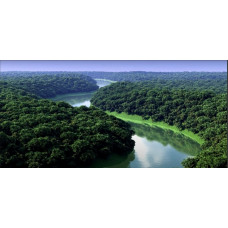A depression of land formed by the erosive activity of water flowing down the surface of the earth on either side of the channel of a modern stream, never completely flooded by water.
Negative, linear-extended form of relief with a monotonous dip. Small forms of river valleys are gullies, gullies, and ravines created by non-permanent (periodic) watercourses. Valleys usually form complete systems; one valley opens into another one, which in turn opens into a third one, and so on, until their merging watercourses in one common channel flow into some body of water.
The structure, width and depth of river valleys depend on the power of watercourse, duration of its action, stability of rocks, tectonic activity of territory and other factors. The transverse profile of river valleys can be V-shaped, U-shaped, trough-shaped or other forms; the rudimentary forms of valleys are gullies and gullies. A river valley usually includes a channel, floodplain, floodplain terraces, and bedrock banks; sometimes deltas or cones of withdrawal are formed near the mouth. The slopes of younger valleys are steep or convex, while those of older valleys are concave or stepped. Younger river valleys often have no terraces, and floodplains are not found everywhere. There are mountainous river valleys, which are steep and not very wide (sometimes they look like canyons), and plain river valleys, usually wide, with little depth and steepness of slopes and low gradients. In landscape zones with excessive moisture, river valleys are much more frequent than in arid zones, and their width is greater. The continuation of large river valleys in the shelf zone are submarine valleys. River valleys are of great practical importance both in the history of civilization and nowadays; they are the most populated and actively used in agriculture.
Valley structure:
slopes - areas of the earth's surface bounding the valley from the sides;
bottom or bed - the lowest and relatively flat part of the valley, enclosed between the foot of the slopes;
slope base, the line where the slopes meet the valley floor;
the edge: the place where the valley slopes intersect with the surface of the adjacent area:
terraces - relatively horizontal areas located at different heights above the modern valley floor.
River valleys are a very complex, ramified and at the same time interconnected single system of landscapes. They are clearly isolated physiographically and geographically and contrast sharply in their morphology with the surrounding inland landscapes. Constantly changing direction, wandering river flow leads to great variability of the valley landscape, to its continuous and profound restructuring. River valleys are constantly rejuvenating; one can always observe in them both the most initial stages of relief formation and biogeocenosis development and the later ones. Hydrological peculiarities are specific for river valleys and have no analogues among zonal types of landscapes: spring-summer floods, rain and wind floods. Unity of river valleys is manifested in high synchronism of floods throughout the longitudinal profile of the valley. Floodplains of plain rivers serve as good hayfields; in places safe from erosion, they are plowed, terraces are also used for sowing all kinds of crops and often serve as locations of settlements (especially in mountainous countries); valley slopes are often covered with forest.
River Valley
Tags: river valley

